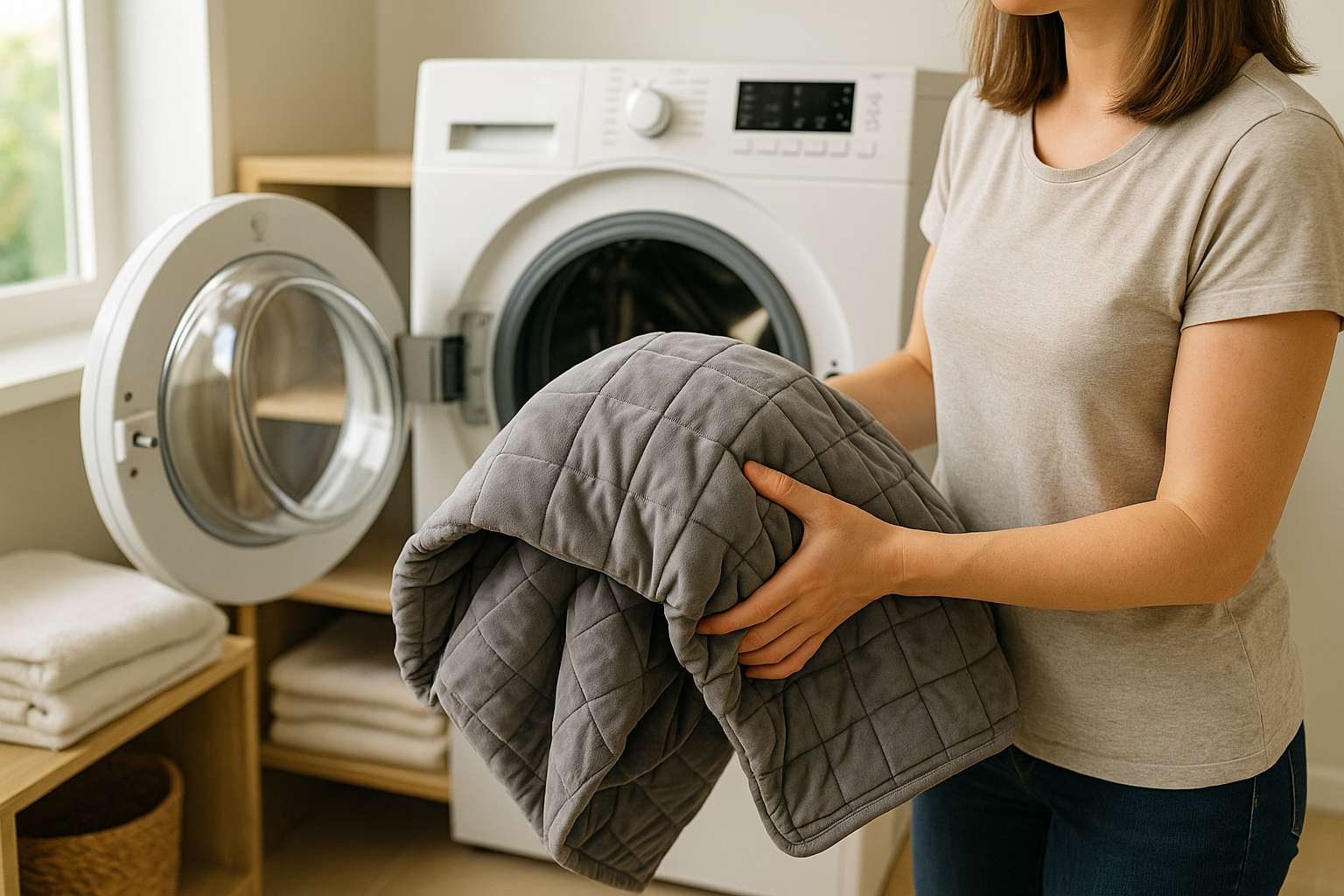Washing a Weighted Blanket: A Complete Guide for 2025
Your weighted blanket is an investment in better sleep and relaxation. But its special construction requires special care. Learn how to wash your weighted blanket safely to protect its fabric, filling, and comforting magic for years to come.
A weighted blanket can be a game-changer for anxiety, insomnia, and sensory needs. But that comforting heft also makes laundry day a little more complicated. You can’t just toss it in the machine like a regular comforter. Incorrect washing can lead to ripped seams, melted filling, and a lumpy, uncomfortable mess.
Here at Blanket Insider, we’ve washed, dried, and tested dozens of weighted blankets of all types and sizes. We understand the hesitation and the questions you have. This guide distills our hands-on experience into a simple, step-by-step process you can trust. By following these instructions, you’ll not only keep your blanket fresh and hygienic but also protect your valuable investment.
The Quick Answer: Can You Wash a Weighted Blanket?
Yes, most weighted blankets are washable, but you must follow specific rules. Here are the key takeaways before you start:
- Always read the care label first. It’s your most important guide.
- Spot clean small stains to reduce the need for full washes.
- Use a large, front-loading washer on a gentle, cold water cycle. Avoid top-loaders with agitators.
- If the blanket is over 15-20 lbs, use a commercial washer at a laundromat to protect your home machine.
- Air drying flat is the safest method. If the label allows, tumble dry on the lowest possible heat setting. Never use high heat.
Before You Wash: The 3 Golden Rules
Before your blanket even touches water, a few minutes of prep can save you from a laundry disaster. Think of this as your pre-flight check.
Rule #1: Check the Care Label (Always!)
This is the most critical step. The manufacturer’s label is the ultimate source of truth for your specific blanket. It will tell you the exact water temperature, cycle type, and drying method that is safe for its materials and construction. Ignoring it is the fastest way to cause irreversible damage.
Rule #2: Know Your Materials
Understanding what your blanket is made of helps you understand the *why* behind the care instructions. The two key components are the cover and the filling.
- Cover Material: Cotton and Minky are typically machine washable in cold water, while delicate fabrics like bamboo or wool may require hand washing.
- Filler Type: The inner weights are crucial. Glass beads and plastic poly pellets are the most common and are generally machine washable. However, plastic pellets can melt in high heat. Blankets with organic fillers (like rice or sand) are almost always spot-clean only, as moisture can lead to mold and rot.
Rule #3: Check the Weight Limit of Your Washer
A standard home washing machine is not designed to handle the intense weight of a heavy, waterlogged blanket. As a general rule, if your weighted blanket is over 15-20 lbs, do not use your home washer. The strain can damage the washer’s motor and drum. For heavier blankets, your best and safest option is to use a large-capacity, commercial washing machine at a laundromat.
Recommended Cleaning Tools & Detergents
Using the right products is just as important as using the right machine. Harsh chemicals can degrade the fabric and irritate your skin. Here are our top picks for safe and effective cleaning.

Tide Free & Gentle Detergent
This detergent is free of dyes and perfumes, making it perfect for sensitive skin and delicate fabrics. It cleans effectively in cold water without harsh chemicals.
Check Price on Amazon
Woolite Delicates
A classic choice for hand washing or delicate cycles. Woolite is specially formulated to not cause shrinking, stretching, or fading, protecting your blanket’s fabric.
Check Price on Amazon
Smart Sheep Wool Dryer Balls
If you tumble dry, these are a must-have. They help circulate air for faster drying, prevent clumping, and soften fabric naturally without chemicals.
Check Price on AmazonThe Washing Process: Machine vs. Hand Washing
Once you’ve done your prep work, it’s time to wash. First, always remove and wash the duvet cover separately if your blanket has one. Then, choose your method based on the care label and the blanket’s weight.
🧼 How to Machine Wash
This is for blankets under 15-20 lbs with a “machine washable” label.
- Wash the Blanket Alone: This ensures a balanced load and allows for proper cleaning.
- Use a Front-Loading Machine: Top-loaders with a central agitator can snag, rip, and stretch the blanket’s seams.
- Select a Gentle Cycle: Choose the “delicate,” “gentle,” or “hand wash” setting on your machine.
- Use Cold Water: Always use cold or lukewarm water. Hot water can damage fibers and melt plastic pellets.
- Add a Mild Detergent: Use a small amount of a gentle, bleach-free detergent like the ones recommended above. Avoid fabric softener.
- Run an Extra Rinse Cycle: This helps ensure all soap residue is washed away, preventing skin irritation and fabric stiffness.
🛁 How to Hand Wash
This is the best method for delicate materials or blankets over 20 lbs (if you can’t get to a laundromat).
- Fill a Bathtub: Use a clean bathtub or a large basin filled with cold or lukewarm water.
- Add Mild Detergent: Mix in a small amount of gentle soap, swishing it around to dissolve.
- Submerge and Soak: Gently press the blanket down into the water until it’s fully submerged. Let it soak for about 30 minutes.
- Gently Agitate: Swish the blanket around with your hands. Press and squeeze sections to work the soapy water through. Do not twist or wring it.
- Drain and Rinse: Drain the soapy water and refill the tub with clean, cool water. Press on the blanket to rinse out the soap. Repeat this step until the water runs clear and free of suds.
- Remove Excess Water: Do not wring the blanket. Gently fold and press it against the side of the tub to push out as much water as possible. You can also roll it tightly in a few large, dry towels to absorb more moisture.
The Crucial Drying Step: Patience is Key
Improper drying is just as risky as improper washing. High heat can destroy your blanket’s filling, and insufficient drying can lead to mildew. Here are the two safe methods.
Method 1: Air Drying (Safest & Recommended)
This is the best method for all weighted blankets. Lay the blanket out flat over a large, clean, dry surface. You can use a bed of clean towels, several drying racks pushed together, or a clean sheet on the grass on a sunny day. Flip the blanket every few hours to ensure even drying. Be prepared—this can take 24 to 48 hours.
Method 2: Tumble Drying (Only if the Label Allows)
Some blankets can be machine dried, but you must be extremely careful.
- Use the Lowest Heat Setting Possible: Select “air fluff” or the lowest temperature setting available. Never use medium or high heat.
- Add Dryer Balls: Toss in a few wool dryer balls or clean tennis balls to help the blanket tumble, prevent clumping, and speed up drying time.
- Check Frequently: Pause the dryer every 30 minutes to check on the blanket, fluff it out, and ensure no part of it is overheating.
Beyond the Wash: Total Blanket Care
Proper cleaning is just one part of blanket maintenance. A little upkeep goes a long way for all the comfort items in your home. While you’re learning if you can wash a weighted blanket, you might also be curious about how to care for a specialized heated blanket. The principles of gentle care extend to all your family’s favorites, from the best swaddle blanket for your newborn to the rugged blanket you take to the beach. And when they’re all clean, storing them neatly on a blanket ladder keeps them fresh and ready for the next snuggle session.
Final Checklist: Washing Your Weighted Blanket
Feeling ready? Run through this quick checklist before you begin.
- Read the care label
- Check blanket weight (under 15 lbs for home washer)
- Remove and wash the duvet cover
- Spot clean any major stains first
- Use a front-loading washer (or bathtub)
- Wash the blanket by itself
- Select a gentle cycle with cold water
- Use a small amount of mild detergent
- Run an extra rinse cycle
- Air dry flat (preferred) or tumble dry on low heat
- Ensure it’s 100% dry before use or storage
By following these steps, you can confidently and safely wash your weighted blanket, ensuring it remains a clean, comforting, and effective tool for relaxation for many years. You’ve got this!

